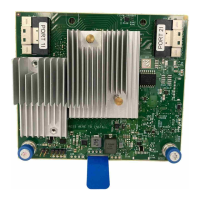RAID 50RAID 50
RAID 50 is a nested RAID method in which the constituent drives are organized into several identical RAID 5 logical drive sets (parity
groups). The smallest possible RAID 50 configuration has six drives organized into two parity groups of three drives each.
For any given number of drives, data loss is least likely to occur when the drives are arranged into the configuration that has the largest
possible number of parity groups. For example, four parity groups of three drives are more secure than three parity groups of four
drives. However, less data can be stored on the array with the larger number of parity groups.
All data is lost if a second drive fails in the same parity group before data from the first failed drive has finished rebuilding. A greater
percentage of array capacity is used to store redundant or parity data than with non-nested RAID methods (RAID 5, for example). A
minimum of six drives is required.
The maximum number of drives supported for RAID 50 is 256.
This method has the following benefits:
Higher performance than for RAID 5, especially during writes.
Better fault tolerance than either RAID 0 or RAID 5.
Up to n physical drives can fail (where n is the number of parity groups) without loss of data, as long as the failed drives are in
different parity groups.

